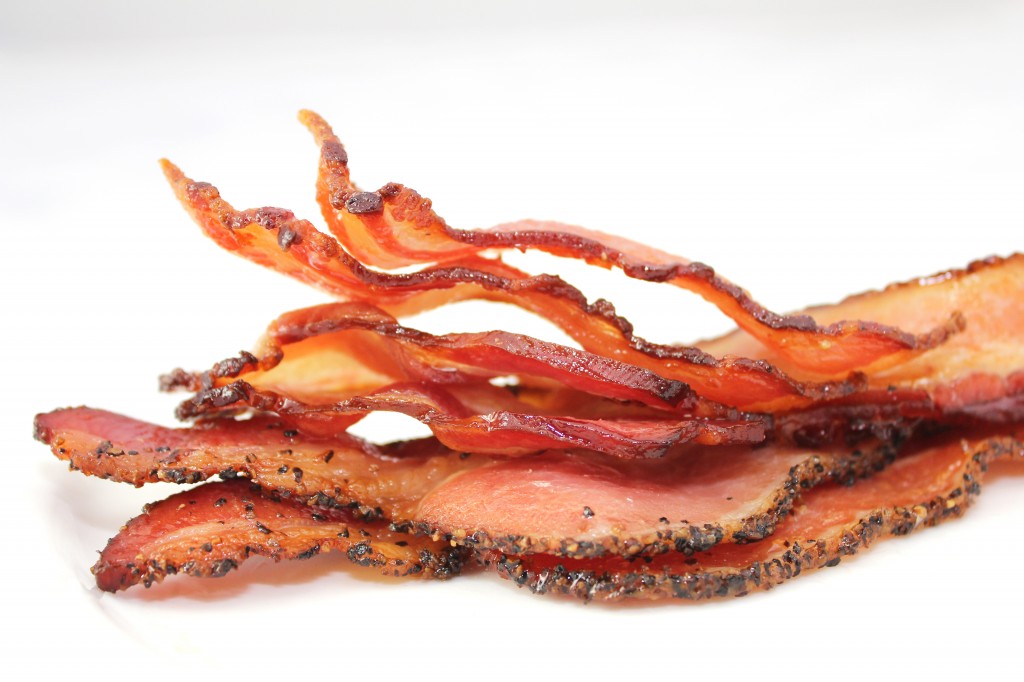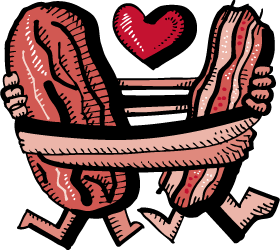What IS Bacon Anyway?
Zingerman’s 5th Annual Camp Bacon gets underway in just a few short weeks. To help you prepare for our annual celebration of all things pork, we’re posting excerpts from the Zingerman’s Guide to Better Bacon.

Well, I thought that was a pretty simple question. But bacon, like most things in life, turned out to be more complicated than I’d originally anticipated. Up until the latter part of the sixteenth century, bacon (or “bacoun”) was a Middle English word that people used to refer to pork of any sort. The term is likely taken from the French bako, Common Germanic bakkon and Old Teutonic backe, all of which refer to the “back,” the part of the pig typically used for bacon-making in Europe.
Interestingly, and oddly, bacon as we know it over here in the U.S. comes not from the back but from the belly and side of the pig. That seems to be an anatomical disconnect until you realize that in Europe the term “bacon” means something entirely different than it does over here. William Tullberg, whom I know from his work with Wiltshire Tracklements, an excellent line of British mustards and condiments, actually started his career working with the Harris family, who are responsible for the now well-known (in Britain, not here) Wiltshire Cure bacon. Tullberg explained that the belly is not where it’s at in the British bacon world. “An Englishman (even a quarter Swedish one, like me),” he writes, “thinks of bacon in terms of a whole cured Wiltshire side, gammon, back, streak, and shoulder. Asking for ‘bacon’ in a shop, he would expect to be offered sliced back or streak, smoked or green. The gammon is sold either as a joint to be cooked as ham, or sliced as gammon rashers, and the shoulder is sold as a joint, and when cooked, is often referred to as ‘shoulder ham.’”

Bacon Down Under
Lance Corporal Bacon is basically a block of pork fat with a small streak of pork meat. It got its name during WWI from Australian and New Zealand Army Corps troops, who were regularly served it as part of their rations. The name was bestowed because the thin strip of meat in this low-end, made-for-the-military pork belly echoed the single stripe on a lance corporal’s sleeve. Very witty, those Australians.
While I’m sure that that explanation makes perfect sense to William, he had me completely lost before he even finished the second sentence. I was wandering the British outskirts of Camp Bacon, with neither a compass nor a British-American dictionary to guide me. I’d heard the word “gammon” a million times, but I had no idea what one actually was. Fortunately, William was willing to assist, so… with his help and a couple of successful keyword searches I quickly learned that the term comes from old French, and refers to the rear leg of the pig. It was apparently used centuries ago to describe whole sides of pork, including both the back and the belly. Today, gammon is generally defined more narrowly to mean a ham: hence, a “gammon steak” is a ham steak. And “green” means cured but not smoked.
It’s not easy being green… or at least it’s not so easy to understand what all this is about. As William said, “I’ve seen many a mystified Englishman unable to understand that bacon in America means cured belly pork, complaining bitterly that his breakfast bacon and eggs was not right, because he expected sliced back bacon!” Maynard, the one-named British author of one of my favorite books about bacon, Adventures of a Bacon Curer, confirms the confusion. (Since you’ll be seeing his name many times as you read, I should mention that it’s pronounced in a sort of Anglicized French as “may-NARD,” with the emphasis mostly, though not fully, on the second syllable, rather than the way I grew up with here, which is more like “MAY-nerd.”) In recounting the story of his first trip to the U.S.—a visit with a bacon-making Pennsylvania Amish farm family—he writes that, “I thought it was a lovely bacon.” It was “streaky,” he explains, and not the sort that he was used to making in Britain, which would have been cured loin. The latter, he adds, “was not cured, they eat the loin as [fresh] pork.”
The terminology clearly causes confusion. So hopefully this glossary will help English visitors avoid embarrassment in the U.S., and Americans avoid any gaffes in the UK.
We’ll see you at Camp Bacon 2014!





Zingerman’s Art for Sale